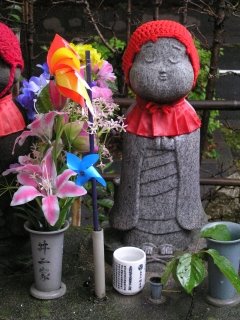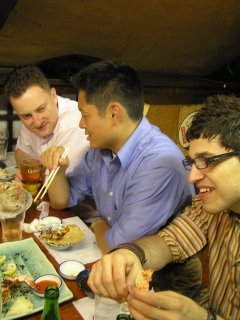
One of Richard's favourite places to eat is an izakaya owned by a British man, Andy. It is literally located under the train tracks of a JR stop (Japan Railways). The Yamanote line roars above as patrons gorge on daily-fresh seafood and
nama bieru (draft beers).
The mix is about half foreigners and half Japanese. Each come for the "authentic" experience. For the foreigners, they are looking for working class / salaryman food. For the Japanese, they can rub elbows with foreigners ("Westerners" as they say) they might otherwise only pass in their daily lives.
According to Richard, the legend of Andy's is as follows:
A British man, Andy, married a Japanese woman and ran an izakaya with her parents. (Andy is fluent in Japanese.) After some time, her parents become disillusioned with Andy working as a waitor at an izakaya. After a fight with the family, Andy and his wife stopped working with her parents.
In a matter of months, the her parents' izakaya went out of business. It needed the perfect mix of
gaijin (foreigners) and Japanese to survive. After a make-up between the families, they opened a new izakaya with smash success. Today, it is under the Yurakucho JR station and across the street from the Hibiya Tokyo Metro station on the Hibiya line.
This is a picture of Igor Ignjic, a coworker of mine, eating a tiger shrimp. It is the size of a small lobster! (His name in
katakana is Iguru Igunitsu.)
 There was a wedding inside the Meiji Jingu Shrine this day. I was fortunate enough to watch as the bride walked through the main courtyard. It all happened so fast, I was only able to take this photograph. The angle would have been better from the other side, but the contrast of the red umbrella and the greenery is still excellent.
There was a wedding inside the Meiji Jingu Shrine this day. I was fortunate enough to watch as the bride walked through the main courtyard. It all happened so fast, I was only able to take this photograph. The angle would have been better from the other side, but the contrast of the red umbrella and the greenery is still excellent.
















